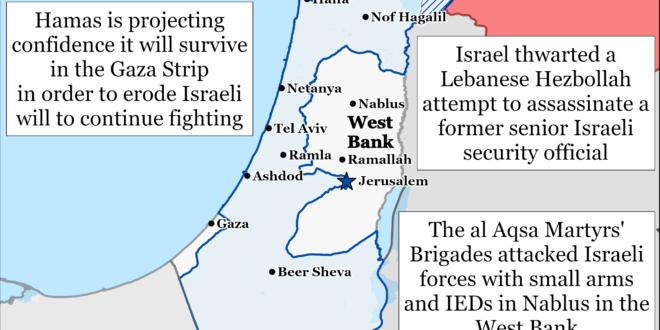Israel simultaneously detonated thousands of pagers used by Lebanese Hezbollah members across Lebanon and Syria on September 17.[1] Lebanese officials reported that around 2,800 individuals were injured, though some reports suggest that the number is closer to 4,000, most of whom are Hezbollah members.[2] The attack also injured the Iranian ambassador to Lebanon, Mojtaba Amani.[3] Hezbollah mourned the death of 12 fighters after the attack but did not explicitly acknowledge how they died.[4] Israel reportedly executed the attack by planting one-to-two ounces of explosive material and remote triggers inside a batch of Taiwanese-made pagers en route to Lebanon.[5] Hezbollah had ordered the pagers to communicate across its ranks, as Hezbollah Secretary General ordered group members to limit cellphone usage in order to avoid Israeli detection.[6] Hezbollah responded to the attack by blaming Israel and vowing to retaliate.[7]
The attack has likely had several negative effects on Hezbollah military effectiveness at least temporarily. The attack likely disrupted some internal communications across Hezbollah, especially given the extent to which Hezbollah has been relying on pagers in recent months. The nature and scale of the attack also likely stoked confusion and shock among some Hezbollah members. These effects could drive general paranoia within Hezbollah as well, given that Israel has demonstrated repeatedly in recent months how deeply it has infiltrated Iranian and Iranian-backed networks.
Israel announced on September 16 that it thwarted a Lebanese Hezbollah attempt to assassinate a former senior Israeli security official.[8] The Shin Bet located at an unspecified location an anti-personnel mine that a Hezbollah cell was planning to use for the assassination in the ”coming days.”[9] The mine was connected to a camera and a remote-controlled detonator. The Shin Bet reported that the mine was “nearly identical” to ones previously used by Hezbollah.[10]
The Israeli security cabinet approved “returning the residents of the north securely to their homes” as an official war objective on September 16.[11] The Israeli security cabinet’s approving this addition marks the first time that northern Israel is officially included in Israel’s stated war objectives.[12] Israeli Prime Minister Benjamin Netanyahu said on September 12 that a political settlement alone will not return displaced citizens to northern Israel and that Israel is “preparing for a broad campaign” to this end.[13]
The Israel Defense Forces (IDF) is in the process of defeating Hamas militarily in the Gaza Strip. The IDF has very likely degraded severely the two Hamas brigades in the southern Gaza Strip.[14] Hamas attacks decreased dramatically since August 2024, reflecting this degradation.[15] Israeli operations have destroyed the bulk of Hamas’ rocket supply as well, leading to a significant decline in Hamas rocket attacks.[16] Hamas is likely no longer operating as an effective and well-organized fighting force. Hamas is instead fighting in a disorganized manner through small, de-centralized cells of fighters across the Gaza Strip.[17]
Israel is meanwhile continuing to pursue its stated war aim of destroying Hamas as a military force and governing authority in the Gaza Strip.[18] Destroying Hamas militarily is a greater undertaking than defeating it and requires Israel—per US military doctrine—to physically render Hamas forces combat ineffective unless reconstituted.[19] Destroying Hamas as a governing authority requires Israel to replace Hamas with a new entity or force that can provide the civil services and security that the Hamas government has provided to Gazans.
Hamas is projecting public confidence that it will survive in the Gaza Strip as part of an information operation to erode Israeli will to sustain the war. Hamas cannot defeat Israel militarily in this war and is instead trying to compel Israel to accept defeat. Senior Hamas official Khaled Mashal said in an interview that Hamas will play a “dominant role” in the post-war Gaza Strip.[20] Hamas has also exploited Israeli hostages to increase Israeli domestic pressure on the government to agree to a ceasefire-hostage deal that would allow Hamas to survive. Hamas has, for example, published propaganda videos of hostages to reinforce the perception that Israel can only secure the release of living hostages through negotiations rather than military operations.[21] Mashal admitted in his interview that Hamas is in no rush to conclude ceasefire-hostage negotiations with Israel and will remain committed to its maximalist demands, which include a complete IDF withdrawal from the Gaza Strip.[22]
Hamas has articulated its own post-war vision for the Gaza Strip to further cement its enduring influence there. Hamas has repeatedly advocated for a Palestinian unity government to take control of the strip after the war and even signed an agreement with Fatah in July 2024 to that end.[23] CTP-ISW previously argued that Hamas could use its functioning military and internal security wings to coerce technocratic government employees at every level, thus providing Hamas with significant influence over the Gazan government even if Hamas officials were not officially controlling it.[24] Remnants of Hamas’ military and internal security organizations could still coerce government officials in any future Gazan Authority, though those efforts may initially lack overarching guidance from higher echelons of command.[25] A lack of central control of such efforts would initially impede Hamas’ efforts to exert influence over a future Gazan governing authority, but Hamas would almost certainly rebuild the control necessary to overcome this deficiency. Israeli efforts that focus on disrupting remaining elements of Hamas’ civil rule, such as its role in the distribution of humanitarian aid, would make it more even more difficult for Hamas to do so.[26]
Russian Security Council Secretary Sergei Shoigu arrived in Iran for an unannounced visit on September 17 following recent visits to Syria and North Korea and amid ongoing Russian efforts to secure military support from allies. Shoigu met with Iranian President Masoud Pezeshkian and Supreme National Security Council Secretary Ali Akbar Ahmadian and conveyed an unspecified message from Russian President Vladimir Putin.[27] The Islamic Republic of Iran Broadcasting (IRIB) reported that Ahmadian and Shoigu discussed upcoming bilateral agreements.[28] Pezeshkian told Shoigu that Iran will work to increase cooperation and deepen bilateral relations between the two countries to reduce the impact of Western sanctions.[29] Shoigu previously met with Syrian President Bashar al Assad in Damascus, Syria, on September 16 and discussed strengthening bilateral relations and regional and international security issues.[30] Shoigu also recently visited Pyongyang on September 13 and met with North Korean President Kim Jong Un for unspecified bilateral discussions.[31] Shoigu’s international visits are coming over the backdrop of the recent Iranian delivery of over 200 Fateh-360 short-range ballistic missiles to Russia, ongoing North Korean military support for the Russian war in Ukraine, and Ukrainian reports that Russia is hiring Syrian mercenaries to fight in Ukraine.[32] Russia’s deepening engagement with China, Iran, and North Korea is part of a wider Kremlin effort to establish a coalition of friendly states that could bolster Russia’s defense industrial base and secure economic cooperation to support its war in Ukraine.[33]
A Washington-based think tank reported that Iran has in recent months increased its operation at two nuclear sites that were previously used for high explosive testing.[34] The report noted that this increased activity—paired with the growing Iranian stockpile of highly enriched uranium—could shorten the Iranian breakout timeline for producing a nuclear weapon to about one week.[35] The Institute for Science and International Security, citing unspecified Western intelligence sources, reported specifically that Iran has ”reactivated and accelerated” activities at the Sanjarian and Golab Dareh nuclear sites in Tehran Province in recent months.[36] The institute also observed through satellite imagery an increase in human traffic, landscaping, and physical security at the Sanjarian site.[37] The Sanjarian and Golab Dareh sites were both involved in Iran’s pre-2003 nuclear weapons program, according to documents retrieved by Israel in a clandestine operation in Iran in 2018.[38]
This report comes as Iran has taken several other measures to expand its nuclear program in recent months. Iran has increased its stockpile of weapons-grade uranium, installed new cascades of advanced centrifuges, and conducted metallurgical testing and computer simulations that could support the production of a nuclear weapon.[39] Russia has separately begun giving Iran unspecified nuclear assistance in exchange for Iran sending ballistic missiles to support the Russian invasion of Ukraine.[40]
Key Takeaways:
- Israel-Hezbollah conflict: Israel simultaneously detonated thousands of pagers used by Lebanese Hezbollah across Lebanon and Syria. The attack has likely had several negative effects on Hezbollah military effectiveness at least temporarily.
- Israel-Hezbollah conflict: The Israeli security cabinet approved “returning the residents of the north securely to their homes” as an official war aim. Israeli leaders seek to push Hezbollah away from the Israel-Lebanon border to allow displaced citizens to return to northern Israel.
- Gaza Strip: The IDF is in the process of defeating Hamas militarily in the Gaza Strip. Hamas is projecting confidence outwardly that it will survive in the Gaza Strip as part of an information operation to erode Israeli will to sustain the war.
- Iran-Russia cooperation: Russian Security Council Secretary Sergei Shoigu arrived in Iran on an unannounced visit following recent visits to North Korea and Syria and amid ongoing Kremlin efforts to secure military support from allies.
- Iranian nuclear program: A Washington-based think tank reported that Iran has in recent months increased its operations at two nuclear sites that were previously used for high explosive testing. This activity could shorten the Iranian nuclear breakout timeline to a week.
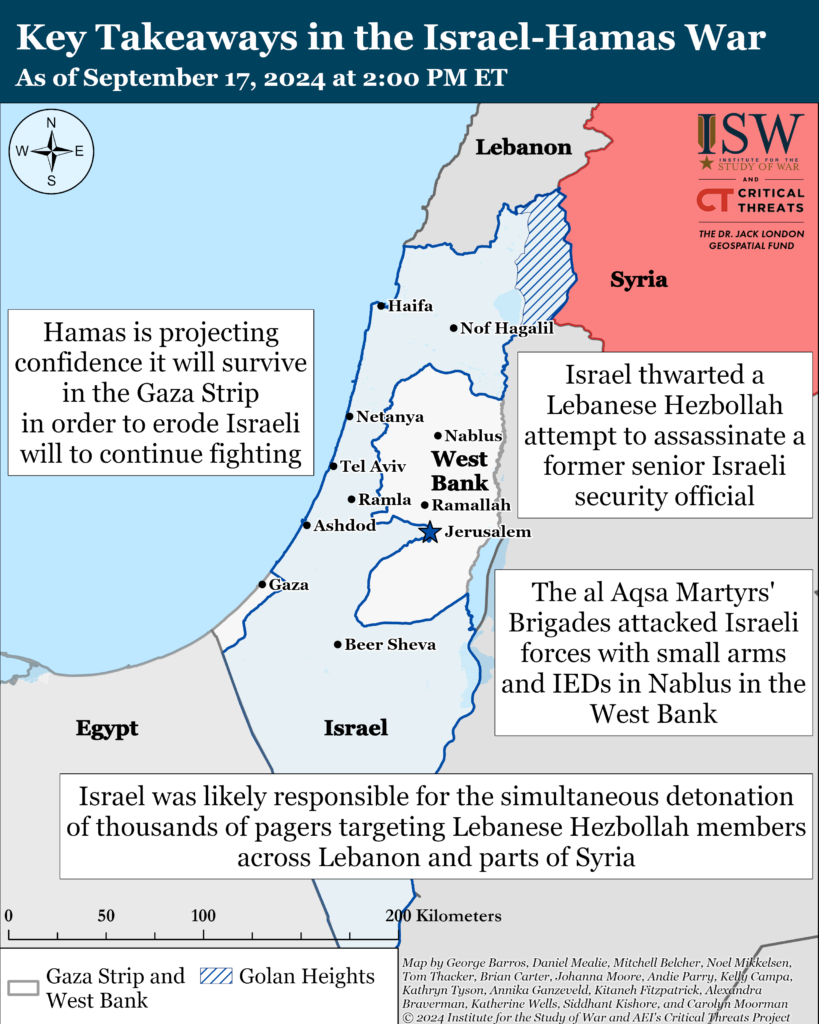
Gaza Strip
Axis of Resistance objectives:
Erode the will of the Israeli political establishment and public to sustain clearing operations in the Gaza Strip
Reestablish Hamas as the governing authority in the Gaza Strip
The IDF Air Force conducted an airstrike killing the commander of a Palestinian Islamic Jihad (PIJ) rocket unit in a the al Mawasi humanitarian zone on September 16.[41] The IDF said that Ahmed Ayesh Salama al Hashash led PIJ rocket forces in Rafah and was responsible for several rocket attacks from the area into Israel.[42]
PIJ claimed on September 17 that it detonated an explosively formed penetrator targeting Israeli armor in eastern Rafah .[43]
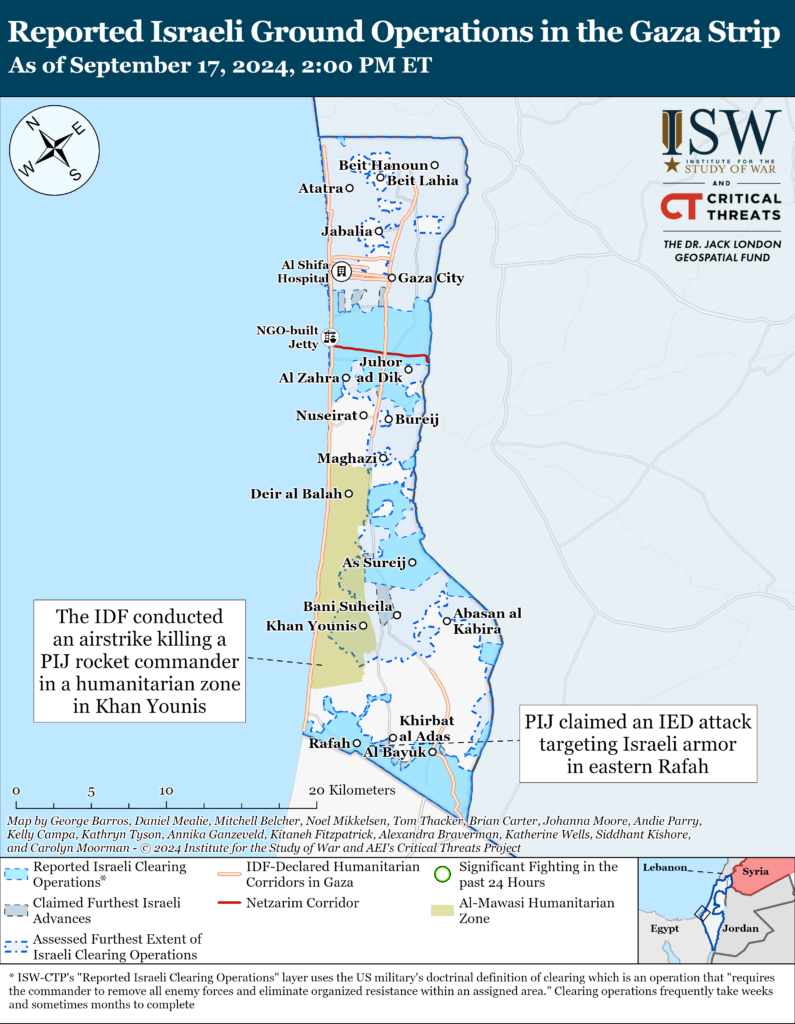
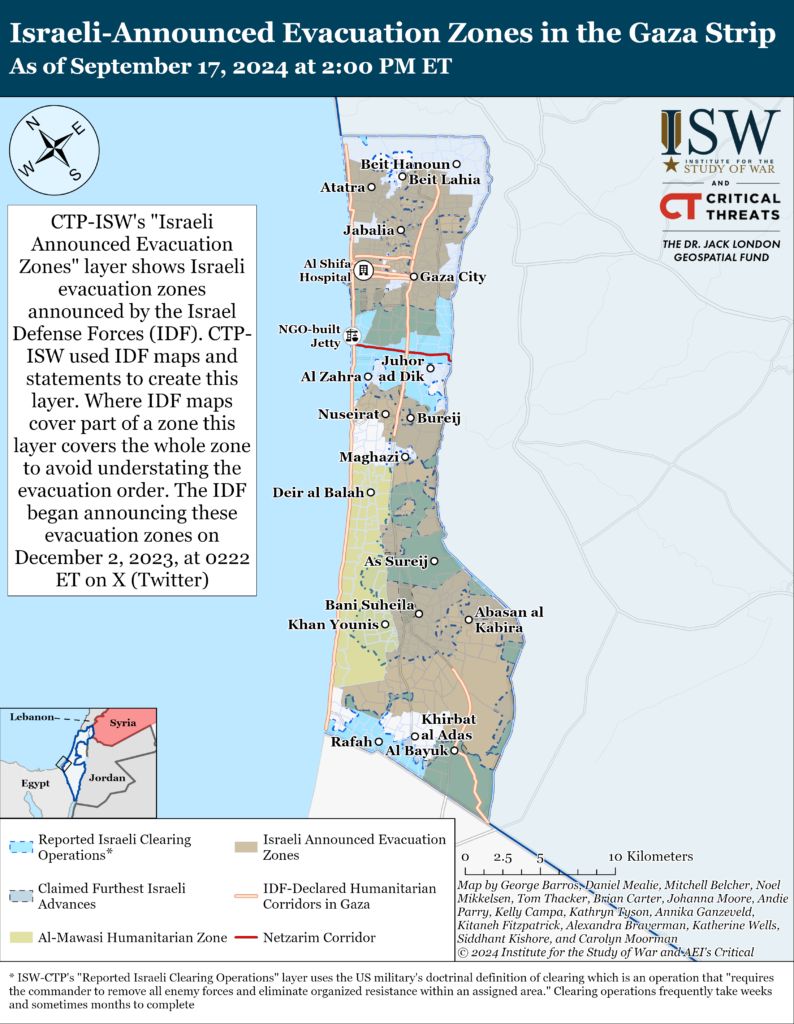
US Secretary of State Antony Blinken traveled to Cairo on September 17 to meet with Egyptian officials and discuss an Israel-Hamas ceasefire-hostage deal.[44] An anonymous official in the region told Western media that the trip is meant to reassure Israel over concerns that Hamas can smuggle weapons and other military materials through the Philadelphi Corridor into the Gaza Strip.[45] Blinken will co-chair the opening of the US-Egyptian Strategic Dialogue with the Egyptian foreign minister during the visit.[46] The dialogue is aimed at strengthening US-Egyptian bilateral relations and increasing economic development.
West Bank
Axis of Resistance objectives:
Establish the West Bank as a viable front against Israel
Israeli forces have engaged Palestinian fighters in at least one location in the West Bank since CTP-ISW’s last data cutoff on September 16.[47]
An Israeli Army Radio correspondent reported on September 17 new details on the establishment of the IDF 96th Infantry Reserve Division.[48] The correspondent said that the division will include about 15,000 reservists and that so far about 25 percent of the openings in the division have been filled. The division will be responsible for border security, possibly in the Jordan Valley, according to the correspondent. The division will also serve as a quick response unit to defend Israeli settlements. The division will be assigned to five different areas. The IDF reportedly estimates that the division will be operational by mid-2025.
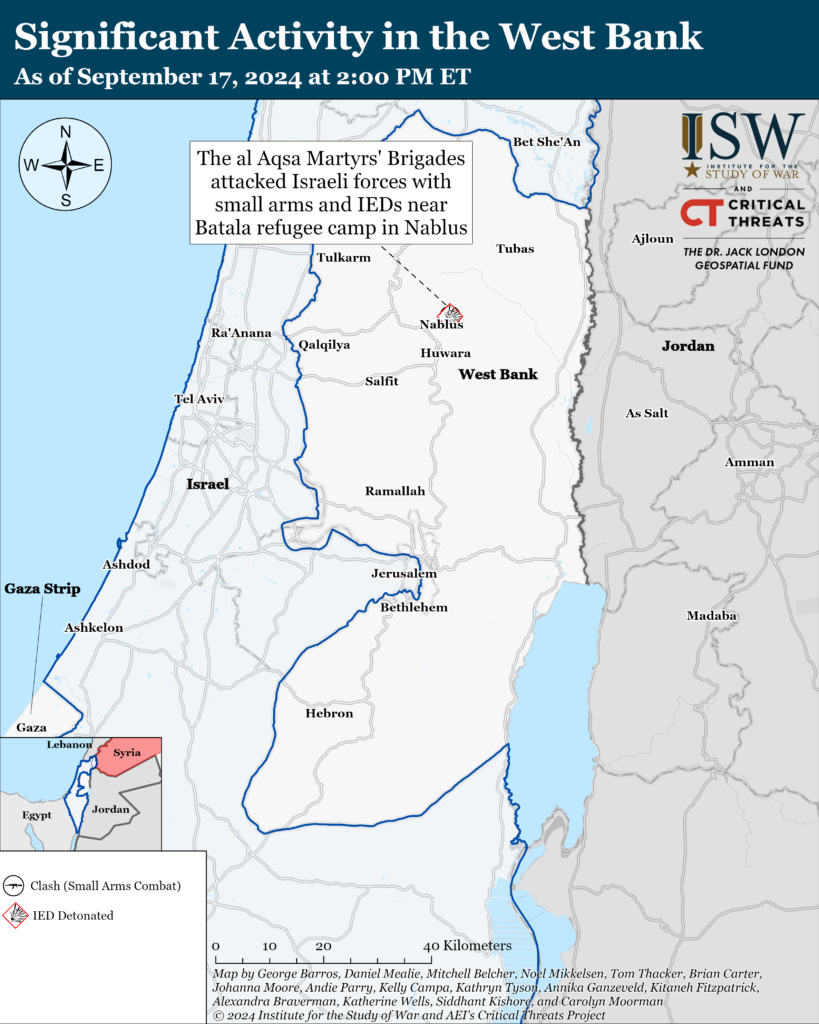
This map is not an exhaustive depiction of clashes and demonstrations in the West Bank.
Southern Lebanon and Golan Heights
Axis of Resistance objectives:
Deter Israel from conducting a ground operation into Lebanon
Prepare for an expanded and protracted conflict with Israel in the near term
Expel the United States from Syria
Lebanese Hezbollah has conducted at least ten attacks into northern Israel since CTP-ISW’s last data cutoff on September 16.[49] Lebanese Hezbollah fired one-way attack drones targeting an IDF site in Ramot Naftali in northern Israel.[50] The IDF stated that it intercepted some of the drones and the remaining fell in open areas causing no casualties.[51]
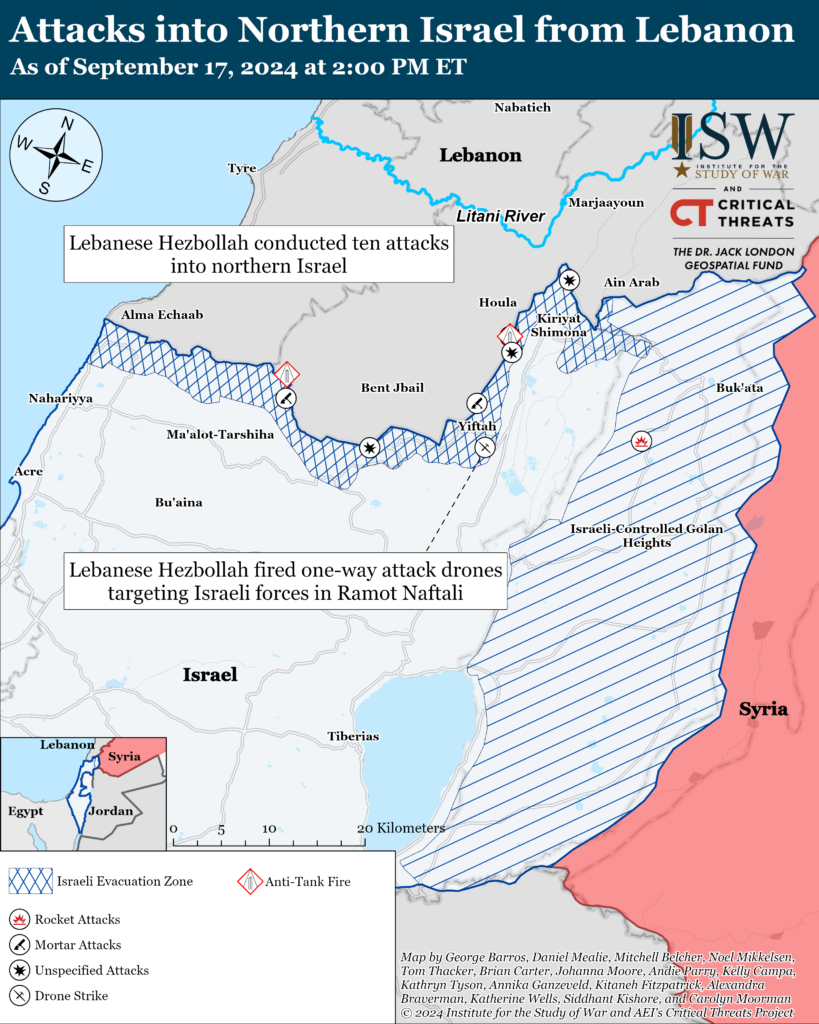
Iran and Axis of Resistance
The Islamic Resistance in Iraq—a coalition of Iranian-backed Iraqi militias—claimed on September 16 a drone attack targeting an unspecified target in “Israeli-controlled territory” in the Jordan Valley.[52]
Iranian Foreign Affairs Minister Abbas Araghchi met with the Lebanese Shia Amal Movement Representative in Tehran Salah Fahs on September 6.[53] Araghchi reaffirmed Iranian support for the Axis of Resistance and praised the “presence and sacrifice of Amal Movement fighters” alongside Lebanese Hezbollah.[54] The Amal Movement has demonstrated coordination with Hezbollah throughout in recent months.[55] The IDF has repeatedly killed members of the Amal Movement and destroyed Amal Movement infrastructure in southern Lebanon throughout the Israel-Hamas war.[56]
Iranian Artesh Coordination Deputy Brigadier General Habibollah Sayyari told Chinese state media on September 16 that Iran will “definite[ly]” retaliate in response to Israel killing Hamas Political Bureau Chairman Ismail Haniyeh in Tehran.[57] Sayyari said that the timing of the attack will not be publicly announced.
Islamic Revolutionary Guards Corps (IRGC) Commander Major General Hossein Salami claimed that Iran has rendered international sanctions ineffective and praised Iran’s “internal achievements” during a speech on September 17.[58] This rhetoric suggests that Salami opposes efforts by the Masoud Pezeshkian administration to resume nuclear negotiations with the West. Salami highlighted that Iran has launched satellites into orbit and constructed railroads, refineries, hospitals, and dams despite Western sanctions.[59] Salami similarly indicated on September 9 that he may oppose resuming nuclear negotiations with the West when he claimed that Iran had “broke[n] the bonds of dependence on foreigners.”[60] The Pezeshkian administration has continued to signal in recent days its willingness to resume nuclear negotiations with the West, as CTP-ISW previously reported.[61]
Atomic Energy Organization of Iran Director Mohammad Eslami met with International Atomic Energy Agency (IAEA) Director Rafael Grossi on the sidelines of the IAEA’s 68th General Conference in Vienna on September 16.[62] Eslami stated that Iran will continue nuclear development within the IAEA framework.[63] Grossi posted on X (Twitter) that he and Eslami “agreed…on the importance of maintaining engagement.”[64] Grossi added that he will visit Tehran “soon” for “important political and technical meetings.”[65]
Eslami separately met with Russian state atomic energy corporation Rosatom CEO Alexei Likhachev in Vienna on September 16 to discuss the two new nuclear reactors under construction at the Bushehr Nuclear Power Plant in Iran.[66] The reactors are part of a joint nuclear cooperation agreement between Iran and Russia.[67] The two countries signed a contract for the construction of the reactors in November 2014. The two units are projected to be completed in 2024 and 2026, respectively. Eslami and Likhachev discussed opportunities for “peaceful nuclear cooperation.”[68]
Iran and Russia are continuing to discuss the construction of the International North-South Transport Corridor (INSTC). Iranian Roads and Urban Development Minister Farzaneh Sadegh discussed the need to complete the INSTC during a meeting with Russian Presidential Aide Igor Levitin in Tehran on September 17.[69] Russia previously agreed to finance the construction of the Astara-Rasht railway, which is a key component of the INSTC. The corridor will provide new market opportunities for Iran and advance its goal of becoming a transit hub in the region. Iranian Economic Affairs and Finance Minister Abdol Nasser Hemmati similarly called for accelerating the completion of the INSTC during a meeting with Levitin on September 16.[70]
Indian External Affairs Ministry Spokesperson Randhir Jaiswal condemned Iranian Supreme Leader Ali Khamenei’s recent remarks about the treatment of Muslims in India.[71] Khamenei posted on X (Twitter) on September 16 that Muslims cannot remain oblivious to the suffering of other Muslims in India, Myanmar, and the Gaza Strip..[72] Jaiswal stated that “countries commenting on minorities are advised to look at their own record before making any observations about others.” Iranian state media separately criticized India on September 11 for supporting Israel .[73]
 Eurasia Press & News
Eurasia Press & News
